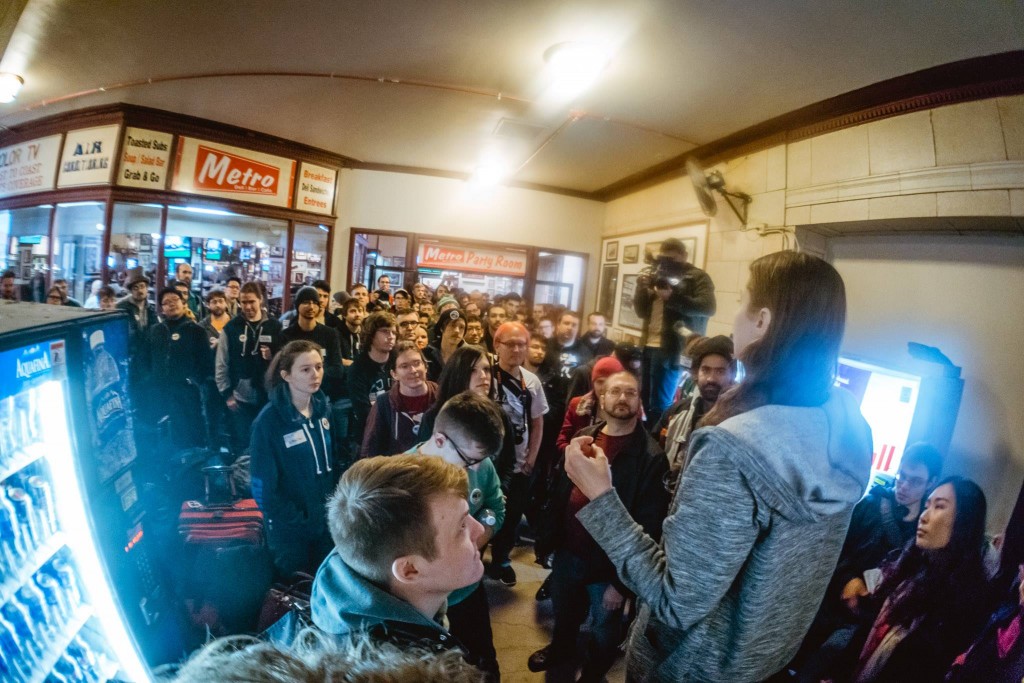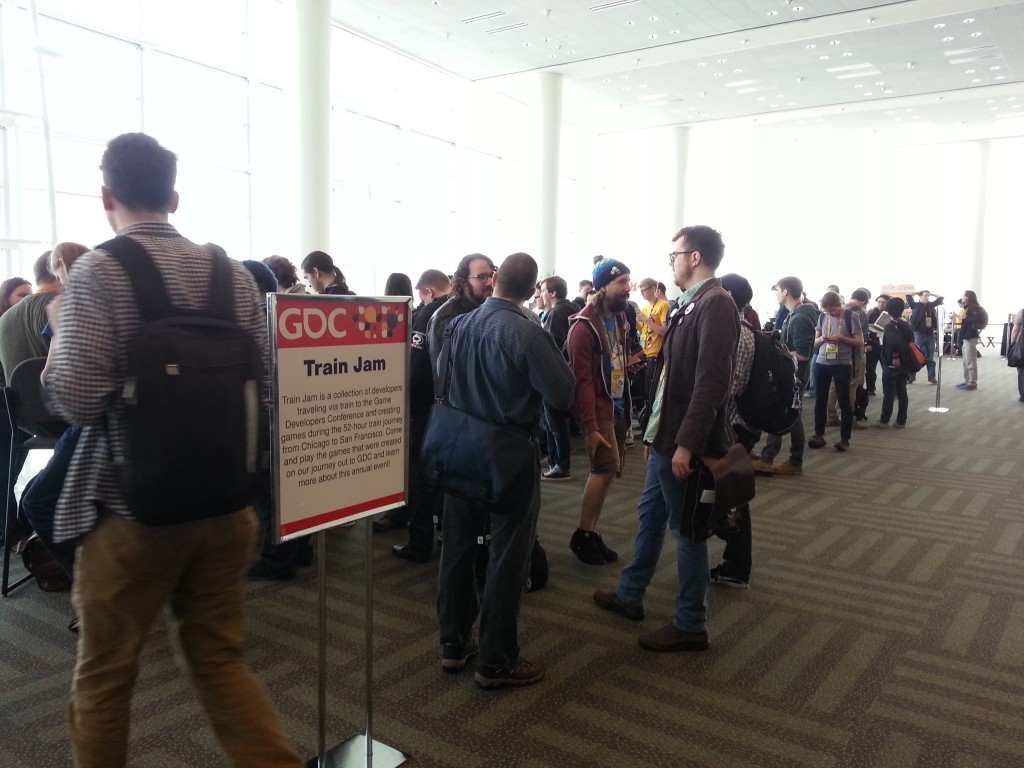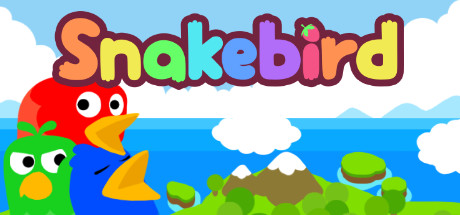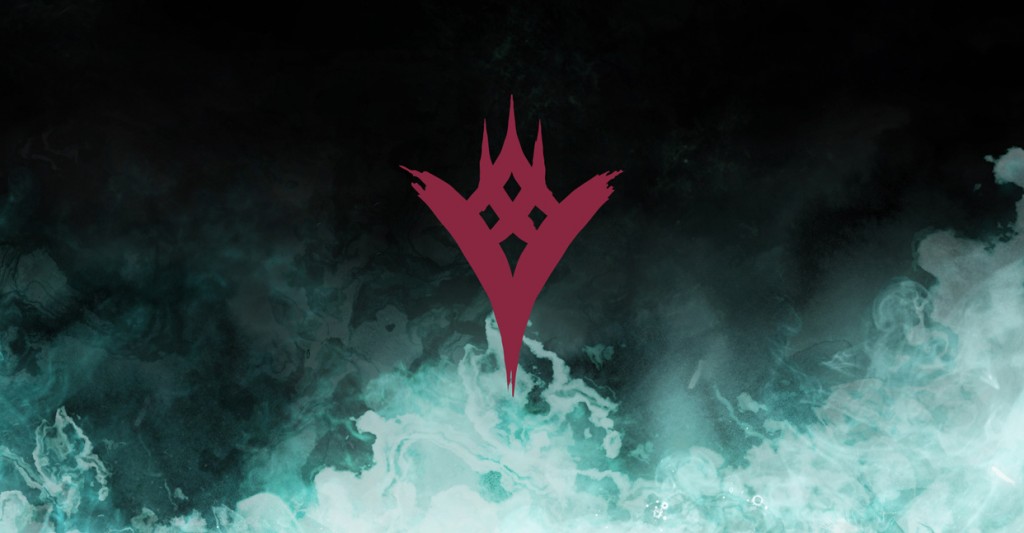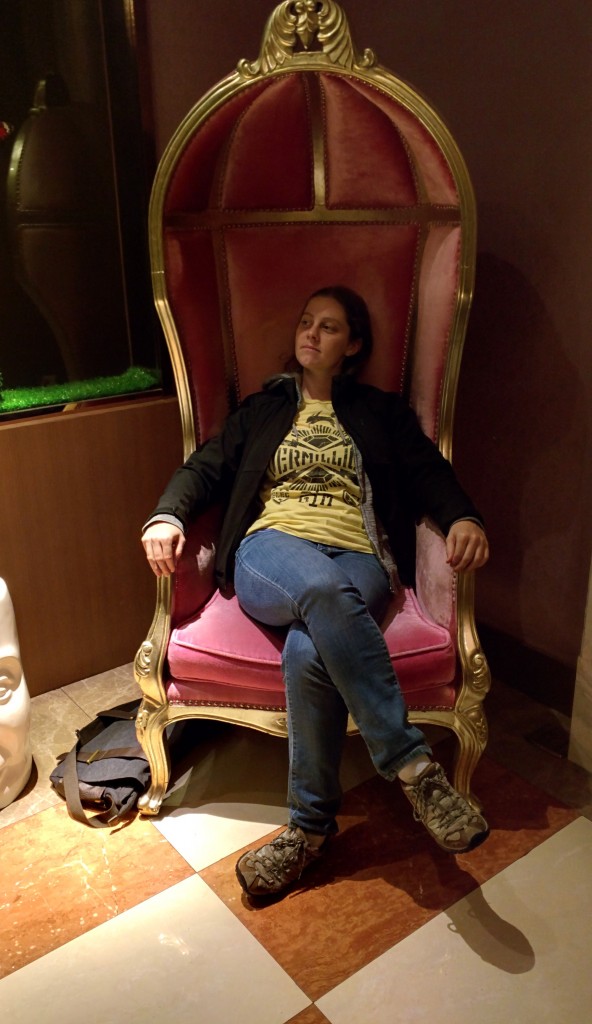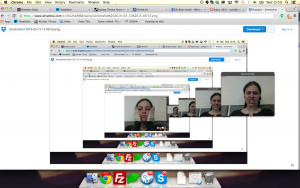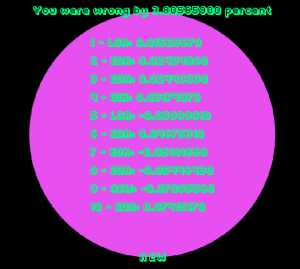Last year I decided that making a “Top 10 games of 2014” list sounded too specific and hard, so I, instead, made a personal list of the “Top 10 things that I saw, played, or did during 2014”. I’m going to continue this tradition with my Top 10 things that I saw, played, or did during 2015, so get ready, because I did a lot of things in 2015 and it was an exciting year all around!
Now, without further ado, and in no particular order….
Train Jam
Train Jam had its second running earlier in 2015 and I couldn’t be happier with how it turned out. In the transition from the 2014 event to the 2015 event, I doubled the size of the reservation, secured double the sponsorship money, and managed to get a space at GDC to display the games created during the jam. With the help of the wonderful John Lindvay, we were also able to start our Student Ambassador Program with the goal of getting more young, aspiring student developers onto the jam and mixed in with the experienced developers that would be in attendance. I did a writeup of the event over on the Train Jam blog, so check it out here if you’re interested in the official statistics of how many Snickers bars remained at the end of the jam.
While I think the jam went incredibly smoothly overall, this year’s Train Jam taught me a valuable lesson about scaling events. It turns out that doubling the size of an event actually requires approximately three times the amount of organization, finances, and logistical help. I was woefully underprepared for how difficult getting 130 people onto a train would be and even less prepared for how quickly sponsorship money runs out when you give 130 people unlimited access to a train’s snack car. While I came out of this year’s Train Jam exhausted, overwhelmed, and at a personal financial loss, it was, again, the absolute highlight of my year. Creating Train Jam has impacted me in so many ways and brings me such a deep sense of joy and pride.
After the 2015 Train Jam event, I almost immediately went into the planning of the 2016 event. I spent a huge chunk of the middle of 2015 coordinating with Amtrak, securing more sponsorship, forging new partnerships for some great initiatives and preparing for our largest ticket sale yet. In November (on my 29th birthday, in fact), I put the 2016 tickets on sale and watched as they sold out in a record 35 seconds. This was such a strange moment as I was both excited about how popular this creation has gotten and terrified about the fact that I was now (with the addition of the jam-only tickets) going to be responsible for 200 people getting onto a train, making games, challenging themselves, and having a good time. I’m excited about the stuff that I have in store for the 2016 event though – only 68 more days!
GDC
GDC 2015 was a whirlwind. It was so much of a whirlwind that GDC actually counts as three spots in my list of the “Top 10 Things I Saw or Played or Did of 2015”. So, let’s go through all of the parts:
Firstly, I gave A LOT of talks at GDC in 2015. I didn’t quite realize how many things I was saying yes to, but by the time GDC rolled around, I was responsible for giving a talk in the IGS, participating in a professional programmer’s panel, and being a part of the 2015 #1ReasonToBe panel. My solo IGS talk was a retrospective of the Game a Week challenge I completed in 2014 and would mark the first time that I would be giving a talk at GDC in San Francisco. The programmer’s panel was a fun hour where myself and other professional programmers were asked questions from students about programming and game development. The most exciting talk for me, however, was the #1ReasonToBe panel. It was a huge honor to be invited to this panel, and I worried endlessly about doing it justice. I finally settled on telling the story of my journey through my childhood of getting into technology and the places that inspired me to pursue technology and, ultimately, game development. Listening to all of the other womens’ stories on the panel was an amazing experience, and I’m so so lucky to have gotten a chance to meet and share a stage with so many inspiring people.
Secondly, I did a lot of other non-talk-giving things at GDC 2015. Here is my short list of the other things I did at GDC 2015 that I never thought I would already be doing this early into my solo indie developer career:
-I had a booth! Like, a whole booth that I was able to use to give the amazing developers on Train Jam a place to show off the games they made! I know it meant a lot to many of the jammers to show off a game at GDC and it made me feel amazing that I could provide them with that opportunity.
-I pitched a game to a bunch of publishers! I spent a lot of the end of 2014 and beginning of 2015 working on a game with a dear friend of mine. We created a small slice of what the game would be and were able to pitch what we had to a number of publishers and consoles and received an enthusiastic response from almost everyone. Though the game has been put on hold for various reasons at the moment, creating something big enough to pitch to publishers and consoles was an amazing feeling.
-I had meetings! So many meetings. Fun fact: securing sponsorships for an event takes a lot of meetings.
So yeah, I did A TON of things at GDC 2015. Which was super exciting and amazing, but also brings me to the third and final part of my GDC section of this list…
I learned my limits. Because of the very nature of Train Jam, I get the privilege of starting every GDC already exhausted and completely drained. As you can see above, I basically had no time to even think about recovering from Train Jam before GDC started. I had to go straight into setting up the Train Jam booth, putting the finishing touches on my game’s demo for pitching, and had to finish/rehearse all of my talks. On top of all of that, my laptop’s motherboard died around midnight of the Sunday night before GDC started. I hadn’t backed up any work externally for over a year (yes, that means that all of my Game a Week games were ONLY on my laptop), I was in the middle of building a game, and…well…it was terrible. I was able to ultimately save all of my data off of my computer, and, luckily Rami had a spare mac for me to borrow until I could fix it, but, suffice it to say, I was a mess during GDC.
There was a moment on the first morning of GDC where an acquaintance of mine (and someone whose work I admire greatly) walked by as I was finishing setting up the Train Jam booth and innocently said hello and asked how I was. I immediately burst into tears and cried on her shoulder for a good solid minute. That’s a pretty good summary of my mental state for the entirety of GDC.
This doesn’t sound like something that should be on a “top 10” list, but I greatly appreciate that I was able to hit this limit. I had plenty of people around to take care of me and help me out, and it gave me a wonderful and practical insight into exactly where my limits lie. Now, I can use this information to better myself for 2016 (I’m proud to announce that I submitted no talk proposals to next year’s GDC).
Press X to be Okay
Press X to be Okay was a game that I started back during a dark period in my life in early 2013. I tabled it for a long while as I had gotten out of the dark period and didn’t have the right motivations to finish it, but luckily (??) I went through another quite dark period in the middle of this year. The causes of my dark period were completely different than the last time, but I was finally back to the right state of mind to finish this long forgotten project. I finished it up, put it on itch.io and slapped a small price tag on it. I know this story actually sounds a little sad, but it marks the very first time I have ever made money off of a game that I created and put for sale! The total sales are still less than $50USD, but hey – it’s something, and that’s a great place to start.
Snakebird
Okay, it’s time to put a game on this top 10 list. Snakebird was probably my favorite game of the year. It’s a puzzle game about snakebirds who like to eat fruit and apparently live in rainbow portal holes. Snakebird is one of those games where the concept is incredibly simple and the puzzles scale up in difficulty super quickly. Somewhere around level 5 is where things start to get real good, and every puzzle that you figure out results in feelings that waver somewhere between “oh goddamnit” and “YES, FINALLY, I’M A GENIUS”. It is a solid, well designed, beautiful game that I seriously cannot recommend enough. If you don’t have it, go buy it now.
China
This year, I was invited to speak at GDC China in Shanghai. In addition to feeling honored to receive the invitation, I was SUPER excited to visit an entirely new continent and culture.
The trip to China started with a few days in Hong Kong as Rami only had a visa for three days in mainland China. Since Rami was busy finishing up Nuclear Throne, I spent a lot of my time in Hong Kong walking around and soaking in the city. I wandered around the city in various attempts to get lost in the city, moseyed around Victoria Park, and stumbled upon a few temples. Rami and I also managed to eat a bunch of local food (including the egg waffle that everyone recommended to us), meet up with a few of the local indie devs, and then go up to the very top of Victoria Peak.
Once we made it over to Shanghai, it was time for GDC China. I’ve given many talks about Game a Week, but I think that this may have been the best version of it. I was feeling particularly inspired when preparing the talk and I think I was able to get all of my points across pretty well. GDC China was a really nice experience overall as I was able to meet a bunch of developers from the region and see new games that I hadn’t seen from the Western game scene. My favorite game I saw while over there was a mobile game called The Swords – I would highly recommend checking it out if you can.
After GDC China wrapped up, I still had a week before I was planning on flying onwards from Shanghai. This time was spent sightseeing with other developers that had been invited to GDC China as well. I made lots of new friends and was able to go on all sorts of adventures. After a few days of Shanghai, some of us moved on to Hangzhou – a city southwest of Shanghai. In Hangzhou, the wonderful Jane Ng guided a few of us through the LongJing Village where we went for a hike through mountains of tea and ate dinner at a wonderful random old woman’s house (who served us fish straight from her fish trap in her front yard’s river!).
The rest of the crew I had been hanging out with moved onto another village, and I decided to stay behind in Hangzhou to have an adventure on my own. Now that I was separated from the one person I knew who spoke Chinese, I was completly alone in a country where I lacked any real ability to communicate with the people around me. I’ve been to plenty of places where English is not the primary language, but this was the first time I had really been somewhere, alone, where English was basically non-existent. Needless to say, I became very very good at pantomiming questions. I also came to appreciate technology a lot. I don’t think I would have been able to really get around Hangzhou without my phone and the instant translation abilities it gave me access to. One of the AirBnB’s that I stayed at was only possible because the host and I could communicate through WeChat’s text translation feature. Once we met up, instead of saying words to each other, we simply texted what we were trying to say in our respective languages, and boom! translated!
All in all, China was full of adventure and pushing myself out of my comfort zone – I am definitely looking forward to the next time that I can make it over to that side of the world.
Oh, also I got food poisoning the last night from some bad sushi – that part sucked….especially because I had a 10 hour flight the next day. Lesson learned: if the sushi you’re eating makes you want to barf while you’re eating it, do not continue eating it.
Dubai
After leaving Shanghai, I flew straight to Dubai for the Dubai World Game Expo to give a talk and lead a panel. I had never been to the UAE before, so it was another opportunity for me to experience a completely new culture. The Dubai World Game Expo was a wonderful event that allowed me to meet a ton of developers from the MENA region all working on really great games. My absolute favorite from the show was a game by the name of Asura. I spent most days playing for an hour or so just trying to get to level 2 (which, I did accomplish!).
It was also fascinating to speak to the developers from this region and hear about the different things that developers struggle with in their respective countries. Due to policies and restrictions, developers from the MENA region deal with all sorts of extra hurdles that many developers in the west don’t even think about (lack of access to dev kits, inability to attend certain events, etc). It was a very eye opening experience and something that I am trying to take to heart when I speak to new developers about pursuing game development.
I also had the pleasure of leading a women in games panel at Dubai World Game Expo. This was extra exciting to me as I felt that we had a very interesting mix of women represented on the panel: we had two developers living in Saudi Arabia, one from Abu Dhabi, one from Los Angeles, and me – also from the US. Moreso than the panel itself, one of my favorite parts of leading this panel was when I had all of the women meet each other the day prior. As a lot of the women didn’t know each other and some where from very different regions and backgrounds, I thought it would be good to get everyone together to meet and find out which topics they would like to discuss and which topics they would like to avoid. This led to many incredibly interesting conversations about feminism and what it meant to each of these women, and it was amazing to see the different things that these women were fighting for (all stemming from the same goal of equality).
I left Dubai feeling more energized and inspired than any other event I’ve ever been to, and I’m so thankful to have been invited to the Dubai World Game Expo.
Destiny
In the next installment of “yes, I actually DID play some games this year”, it’s time to talk about Destiny. With The Taken King expansion releasing, Destiny is, once again, at the top of my list of games I played this year. TTK is fun both narratively and mechanically, but more importantly, it’s a wonderful portal to hang out with my friends around the world. Rami and I have a rule where we only play Destiny with each other (seriously, we’ve basically never played it apart from one another – we even have two TVs and two PS4s), and it has basically turned into our nighttime post-work ritual. We work all day, have dinner, work more, then break for Destiny. We use it as a way to decompress and hang out with each other, then eventually invite friends in to raid, do the daily/weekly/nightfall/whatever, and chat.
Destiny’s new and interesting content that was released this year is one of the only reasons that we can continue to use it as we do (as, yes, the year 1 content was starting to get a bit stale), and I can’t wait to see where they take it in the years to come!
I Got Out of Debt
When I quit my job and started out on my solo indie developer adventure back in 2013, I had a decent amount of savings. Because of that savings, a generally frugal lifestyle, and the help of those around me, I was able to stretch that savings for a little over a year (awesome!) – but then, I started to dip into my credit cards. I picked up an odd contract here and there, but for the most part, I didn’t really focus on trying to make money until partway through 2015 – once my debt got back enough. I’m lucky in that I had never really been in debt until this point in my life, but it definitely was something that ended up weighing on me immensely, and causing me a lot of anxieties.
I ended up having to put all of my personal projects on hold, and switch over to contract work entirely. I formed a company (MsMinotaur, LLC obviously), and started putting my feelers out. Eventually, a contract came up that was an absolute perfect fit. I’ve been spending the last few months working on a really fun game with a guy who is very flexible with my travel schedule, and just genuinely a great person. With this contract, and being able to put all of other stuff on hold, I was finally able to dig myself out of debt juuuuuust shy of the new year starting. I still don’t have much money, but at least it’s all in the green again!
So, there you go – 2015 was an interesting, busy, and exciting year, and I really can’t wait to see what 2016 has in store for me!
